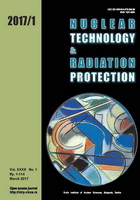
STOCHASTIC SIMULATION STUDY OF HPGe DETECTOR RESPONSE AND THE EFFECT OF DETECTOR AGING USING GEANT4
Pages: 57-69
Authors: Hina Tariq, Sikander M. Mirza, Shakeel Ur Rehman, and Nasir M. MirzaAbstract
In this study the effect of detector aging in terms of increased dead layer thickness on detector efficiency has been studied using the Geant4 toolkit. Variation of energy deposition in the detector dead layer with the dead layer thickness has been quantified for various values of incident γ-ray energy considering point isotropic as well as extended sources including the circular disk source and cylindrical volume sources. For the point isotropic source, the Geant4 computed values of energy loss per particle in the dead layer are found in good agreement with the corresponding published results with maximum deviation remaining below 2 %. New results for dependence of geometric, full-energy peak and total efficiency on dead layer thickness have been studied using Geant4 simulations for various values of γ-ray energy, and for point isotropic and extended sources at various axial and lateral positions. These simulations yield an exponentially decreasing profile of detector aging sensitivity with an increase in γ-ray energy for point isotropic, circular disk and cylindrical volume sources highlighting a larger decrease in efficiency due to aging for low energy photons.
Key words: HPGe, dead layer, detector aging, detection efficiency, Monte Carlo, Geant4
FULL PAPER IN PDF FORMAT (3.65 MB)
